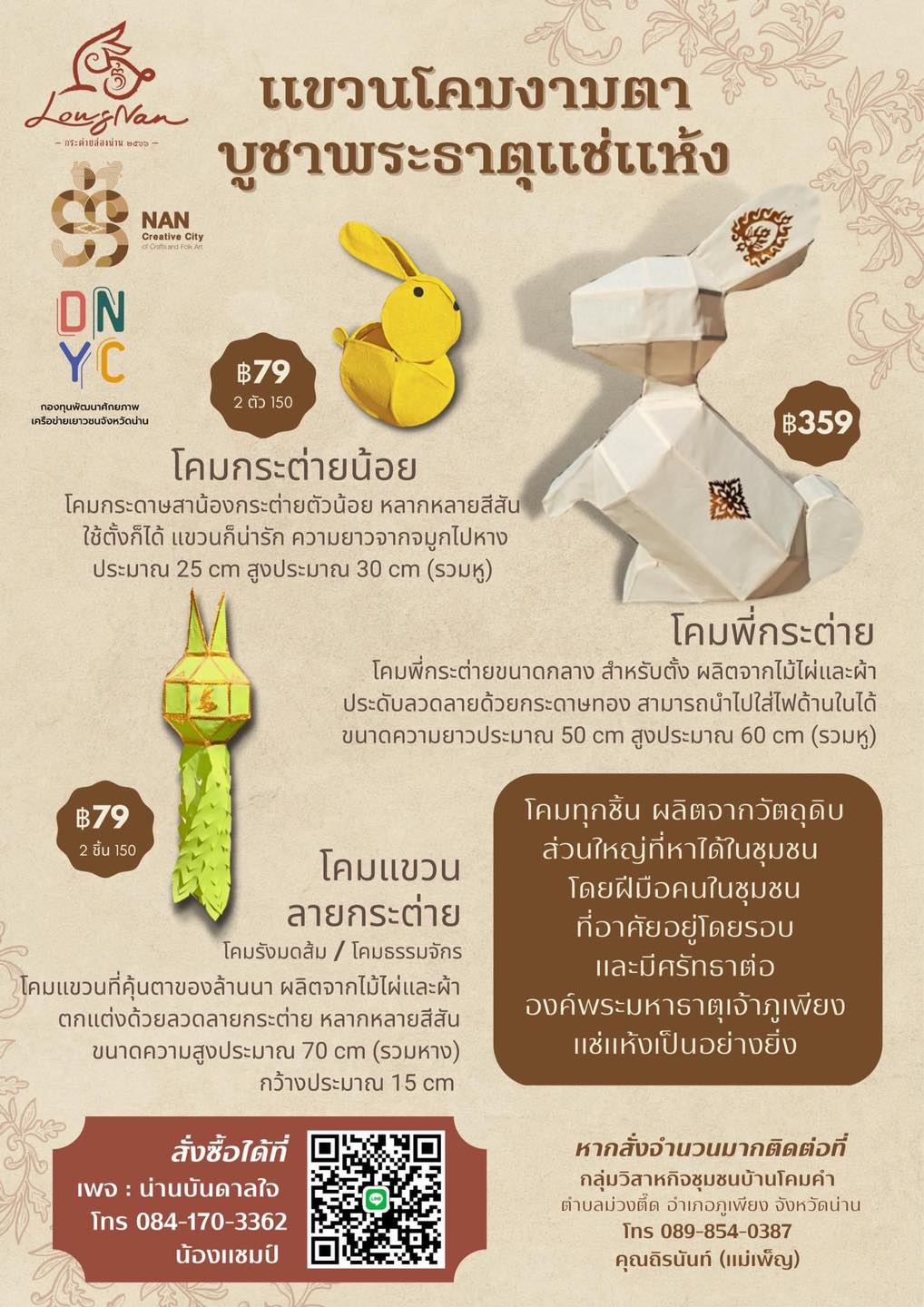The "Year of the Rabbit" Phra That Chae Haeng
2162 Views |

As for the "Year of the Rabbit", it refers to the year in the Chinese lunar calendar which is associated with the rabbit zodiac sign. This year is believed to be a time of peace, tranquility and creativity, as the rabbit is associated with these qualities. The Chinese lunar calendar is based on a 12-year cycle, with each year being represented by an animal sign. The "Year of the Rabbit" occurs approximately once every 12 years.
In Chinese astrology and culture, the year of the rabbit is associated with a number of beliefs and superstitions. Here are some of the most common beliefs:
Peace and tranquility, The rabbit is considered a gentle and peaceful animal, and the year of the rabbit is believed to be a time of peace and calm. People are said to be more harmonious and less argumentative during this year.
Good luck and prosperity, The rabbit is also associated with good fortune and prosperity, and it is believed that the year of the rabbit can bring good luck and financial success.
Creativity and artistic expression, The rabbit is seen as a creative and artistic animal, and the year of the rabbit is believed to be a time of heightened creativity and artistic expression.
Love and romance, The rabbit is also associated with love and romance, and the year of the rabbit is said to be a good time to start a new relationship or to strengthen existing ones.
It's important to note that these beliefs are largely based on superstition and are not supported by scientific evidence. However, many people in China and other East Asian countries still hold these beliefs and see the year of the rabbit as a time of good luck and positive energy.
Phra That Chae Haeng is a Buddhist stupa located in Nan Province, Thailand. It is believed to contain a sacred relic of the Buddha, making it an important pilgrimage site for Buddhists. Stupas like Phra That Chae Haeng are considered sacred structures in Buddhism and are revered as symbols of the Buddha's teachings and the path to enlightenment. People visit stupas like Phra That Chae Haeng to pay homage to the Buddha, to make offerings, and to seek blessings and good fortune. The stupa is also a place of spiritual refuge, and many people come to meditate and reflect on the teachings of the Buddha. If you're interested in visiting Phra That Chae Haeng, it's always a good idea to familiarize yourself with the local customs and traditions so that you can respectfully participate in any ceremonies or rituals that may be taking place.
The people of Nan Province in Thailand likely hold Phra That Chae Haeng in high esteem as a sacred and revered Buddhist site. As a stupa, it is believed to contain a sacred relic of the Buddha, making it a powerful symbol of the Buddhist faith and an important place of pilgrimage. People may visit Phra That Chae Haeng to make offerings, to seek blessings and good fortune, or simply to pay homage to the Buddha and his teachings.
It is also possible that Phra That Chae Haeng is seen as a source of local pride and cultural heritage for the people of Nan Province. As a significant historical and religious site, it may be seen as a symbol of the rich cultural heritage of the region and a source of inspiration for future generations.
Regardless of specific beliefs, it is likely that Phra That Chae Haeng holds great spiritual significance for the people of Nan Province and is an important part of their cultural identity and traditions.
Phra That Chae Haeng, like other Buddhist stupas, is steeped in tradition and ritual. Here are some of the traditional practices associated with stupas like Phra That Chae Haeng:
Pilgrimage, Phra That Chae Haeng is considered a sacred site and an important place of pilgrimage for Buddhists. People may travel from far and wide to visit the stupa and pay homage to the Buddha.
Making offerings, Visitors to Phra That Chae Haeng may make offerings of flowers, incense, candles, or other items as a way of showing respect and gratitude to the Buddha.
Circumambulation, Visitors to Phra That Chae Haeng may circumambulate the stupa in a clockwise direction as a way of paying respect and participating in a traditional Buddhist practice.
Meditation, Phra That Chae Haeng is also a place of spiritual refuge, and many people come to meditate and reflect on the teachings of the Buddha.
Ceremonies and rituals, There may also be ceremonies and rituals held at Phra That Chae Haeng, such as Buddhist festivals and special events, which visitors can participate in.
It's important to note that the specific traditions and practices associated with Phra That Chae Haeng may vary depending on local customs and the specific Buddhist traditions followed in Nan Province. Nevertheless, these are some of the common practices associated with Buddhist stupas like Phra That Chae Haeng.

Invite to hang beautiful lanterns, Worship Phra That Chae Haeng
Invitation to decorate the rabbit lantern on the Hok Peng Festival, paying homage to Phra Mahathat Chao Phu Pieng Chae Dang. Every lamp is made from local raw materials that can be found in the community and make by people in the surrounding communities who have faith in Phra Mahathat Chao Phu Pieng Chae Haeng. Those interested can place orders or asking for more detials at Ban Khom Kham Community, and URL link
https://www.facebook.com/profile.php?id=100063884540490



